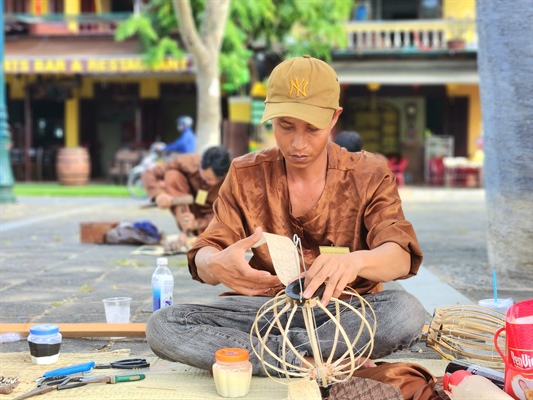(TITC) - Preserving and promoting the value of traditional craft villages, associated with sustainable development is preserving "living space", maximising production activities of crafts, so that artisans can live with traditional craft.

Artists perform "Hoi An Craftsmanship -2023" (Photo: http://baovanhoa.vn/)
There are 4 craft villages and a lantern craft street in Hoi An, including Thanh Ha Pottery Village, Kim Bong Carpentry, Tra Que Vegetable Village and Thanh Chau bird nest exploitation have been recognised as National Intangible Cultural Heritage by the Ministry of Culture, Sports and Tourism. The traditional craft villages in Hoi An are considered as cultural resources, a source of raw materials for the creation, a testament to the effect of tourism in nurturing and stimulating the creative process.
The traditional craft villages in Hoi An have contributed a great deal to the "wealth" of unique tangible and intangible cultural values of the land, including knowledge, professional skills, customs, festivals, folklore, aesthetic values, etc. Festivals of honoring craft ancestors have always been preserved and organized by the authorities and residents of Hoi An, according to tradition form.
Festivals that attract a large number of people and tourists to attend such as Death anniversary of the founder of Kim Bồng Carpentry, Thanh Ha Pottery Village, the bird nest in Cu Lao Cham, Cau Bong Festival in Tra Que Vegetable Village;… Craft village tourism products such as a day as a farmer in Tra Que Vegetable Village, Cam Thanh eco-tourism, old town night, etc. are attractive and unique tourism products of Hoi An. A special feature is that these products are created and developed from "traditional materials" in the space of the craft village such as landscape, traditional architecture, intangible cultural values of the anniversary of the craft ancestors, festivals, cultural activities, performances, folk games, and special cuisine. Along with that is the creativity, persistence in sticking with the craft village, maintaining the motivation of handicraft production activities of artisans, craft villagers, etc. All of these have helped tourism products associated with craft villages and attractive ecological villages, contributing to the sustainable development of Hoi An tourism.
Additionally, traditional craft villages together with handicraft production activities have played an important role in building and developing new countryside, creating jobs and developing tourism in Hoi An. Generations of artisans in craft villages have accumulated rich knowledge about the craft. For instance, Kim Bong Carpentry Village associates with the craft of constructing boats, houses, producing fine art and household goods. Thanh Ha Pottery Village, in addition to the production by hereditary method, the present generation of artisans has improved in the production of fine art ceramics to serve the demands of decoration and export.
Hoi An, towards the goal of "Global Creative City", has always focused on the premier criteria that is the active participation of the community. They participate in decisions related to innovation and development, and also in creative practices for livelihoods and community engagement. Generations of community in Hoi An have created, nurtured, and transmitted unique and diverse heritage values. In which, craft village culture and traditional crafts are important factors in forming and transmitting the cultural flow of Hoi An, contributing to tourism development.
Tourism Information Technology Center